Speech Australian Economic Growth – The How, What and Where

Christopher Kent[*]
Assistant Governor (Economic)
Address to the National RSL Clubs Conference
Hobart –
- Audio 19.41MB
- Q&A Transcript
Introduction
I'd like to thank the Board and members of the RSL & Services Clubs Association for their invitation to speak here.
I want to consider three closely related questions I am often asked:
- How can the Australian economy become more productive?
- What will help generate additional growth (in demand) needed to boost employment?
- Where is that growth going to come from? In particular, which industries will have the profitable opportunities that will lead to more employment and drive investment?
It is hardly surprising that Australians are interested in these questions given the rise in the unemployment rate and sub-trend growth of the economy over the past couple of years.
How to be more productive?
From the middle of the previous decade, Australia enjoyed a sharp run-up in the prices of our key commodity exports. This led to an unprecedented boom in mining investment. The benefits were spread beyond the narrow confines of the mining industry in numerous ways, with strong growth in employment and wages across a range of industries around the country.[1]
But now that commodity prices and mining investment have turned down, it is natural to ask: how are we going to sustain and build on our standard of living over the longer term? This boils down to two essential elements. We can work more (i.e. raise our labour force participation). We can also work more efficiently. In other words, we can boost our (labour) productivity, which is the source of sustainable gains in wages and profits (in the absence of a resurgence in commodity prices).[2] I've spoken elsewhere about participation, so let me focus here on productivity.[3]
There are a number of sources of growth in labour productivity (i.e. output per hour worked):
- technological progress, which supports new business processes and new production techniques as well as more efficient use of productive resources. In other words, an expansion of the technological, or productive frontier
- additional physical capital, both private and public, some of which may embody new technologies
- more human capital (via education and training).
These things have a somewhat formulaic air to them. They suggest that we just need the right combination of inputs so as to produce goods and services as efficiently as possible. But for that to lead to sustainable growth of incomes – of wages and profits – we need to make sure that the goods and services produced are those that people want at a price they are willing to pay. Also, we need to fund investment from domestic or foreign sources of savings, which are provided with the expectation of a reasonable return.
A market-based economy can achieve these things with the help of competitive and flexible labour and product markets.[4] These provide the price and wage signals that encourage labour and capital to move into profitable opportunities and out of unprofitable ones. Competitive markets also encourage companies to seek out efficiency gains and pursue innovations. Developing new products or processes and taking advantage of scientific progress are key drivers of long-term growth.
It helps too for those markets to be supported by a robust institutional framework, such as: the rule of law; effective regulation and oversight of parts of the economy, including to ensure the soundness of the financial system; and institutions to oversee the efficient provision of public services and infrastructure, and encourage prudent management of fiscal and monetary affairs.
Productivity growth was especially strong across many countries, including Australia, over the decade starting in the mid 1990s (Graph 1). There may have been some common sources to this strong growth. An obvious candidate is technological progress.[5] In the case of Australia, and a number of other countries, a range of earlier economic reforms may also have played a role. These included a broad-based deregulation of financial, product and labour markets, further liberalisation of international trade and a program of corporatisation and privatisation of public enterprises.[6] While these things don't push out the technological frontier, they provide an environment that encourages and enables us to get closer to that frontier.
Following this period, there was time from the mid 2000s during which productivity growth was considerably slower than its longer-term average. This slowdown was also common to a number of economies.[7]
However, productivity growth has picked up in Australia over more recent years. Some of this reflects the move from the investment to the production phase of the mining boom, which has seen a strong rise in output combined with a reduction in employment in resource-related activity. But the pick-up in productivity growth is broadly based across other sectors of the economy. This may, in part, reflect the response of businesses to rising competitive pressures following the period when the exchange rate had risen to very high levels, growth of non-mining activity had been relatively weak and wage growth relatively strong. Responding to those pressures is not easy. A common theme from the Bank's liaison program in recent years has been the heightened focus on reducing costs and improving productivity in response to the subdued growth in demand. In more extreme cases, however, it involves businesses that are not sufficiently productive going out of business and workers losing their jobs.
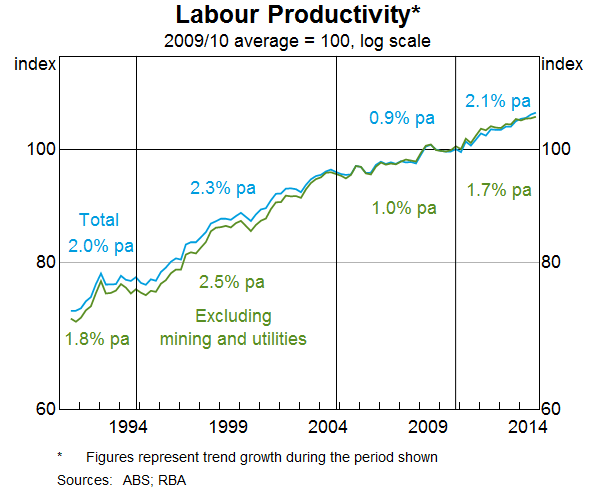
What more could be done to secure strong productivity growth? As others have noted before me, the experts at the Productivity Commission have put together a ‘list’ of what could be done.[8] The list describes how improvements to incentives, capabilities and flexibility could enhance productivity. Again, the idea is not that these things can push out the technological frontier, but they can help us get closer to it. Recommendations to improve incentives largely focus on promoting competition, such as further reducing barriers that inhibit international trade or new entrants to markets. Policies on capabilities focus on the development of human capital, improving infrastructure and government services as well as the institutions for creating and transmitting knowledge (academic institutions and their links with the business community, for instance). The third part of the list deals with providing a more flexible regulatory environment and reducing unnecessary ‘red tape’. Any one policy will be helpful by itself, but it is likely that the combined effect will be greater than the sum of each of the parts.
This discussion has focused on how economies can support growth over the longer term. You will note, however, that I haven't said much about the role of monetary policy. While monetary policy can help to ensure low and stable inflation, and contribute to macroeconomic stability, it cannot influence the longer-term determinants of growth. Even so, monetary policy has an important role in influencing economic activity over the course of the business cycle, which is the subject of the next question.
What will help generate additional growth in demand over the next couple of years?
Since about mid 2012, Australia's GDP growth has been a bit below trend and so the unemployment rate has been rising gradually (Graph 2).[9]
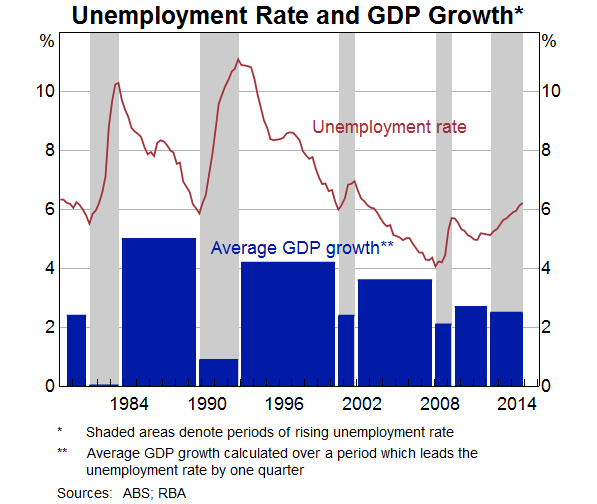
The Bank's recent update to its forecasts has pushed out the time at which we see GDP growth picking up from its current sub-trend pace. It is not that economic growth has weakened of late. But there is little to suggest that it will increase in the near term.
This implies that the unemployment rate will rise for a bit longer and peak a bit higher than previously expected. The question then is what is it that will generate an improvement in the rate of economic growth and lead to a decline in unemployment? What are the triggers for such a revival?
Part of the answer is that the very low level of interest rates is expected to sustain strong activity in the housing market and support household wealth. This will provide some support for consumption, although the response of consumption to low rates may be somewhat less and work in different ways from previous episodes, in part because of the higher levels of household indebtedness now.[10] Low interest rates also work by raising overall cash flows for the household sector (since households are borrowers in net terms) and by encouraging households to bring forward some spending and lower their saving rate a little further.
Looking back over the past year we can see the effect of low interest rates at work. Dwelling investment has grown strongly and made a contribution to demand across all the states (Graph 3). Consumption growth has picked up a bit, particularly in New South Wales, but it remains a bit below average for the nation as a whole. Consumption growth is weakest in Queensland and Western Australia, which are dealing with the direct effect of the decline in mining investment. Business investment is making a positive contribution to growth in the other states. Meanwhile, in line with fiscal consolidation at state and federal levels, public demand has made no contribution to growth for the country as a whole, but the contribution is mixed across the different states.
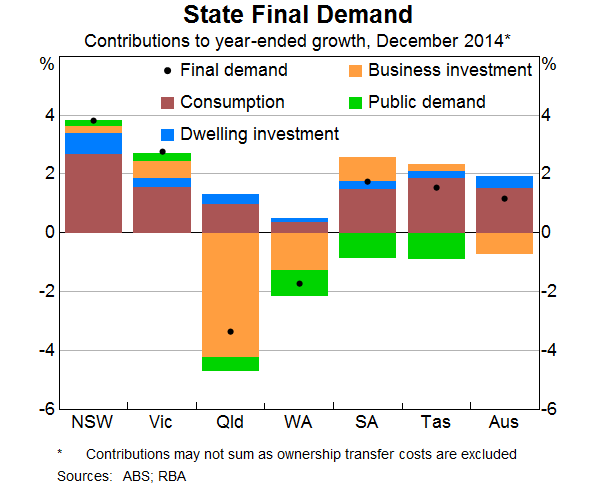
In time, a pick-up in household demand should encourage businesses (outside of the resources sector) to increase employment and undertake more investment. When that occurs, businesses will make more use of funding that is currently readily available at low cost. Also, exports, especially of resources – most notably liquefied natural gas (LNG) – are expected to continue to contribute significantly to growth, while declining mining investment and, to a lesser extent, fiscal consolidation are likely to weigh on growth over the next couple of years.
It's tempting to think that economies are well served by being directed or guided in a way that will produce better outcomes. There is some truth to that. Monetary policy is certainly playing an important role, but it guides things rather imprecisely, with the relatively blunt tool of the overnight cash rate.
Other means of adjustment
Economies are responsive in many other ways that don't require the active input of policymakers. The so-called ‘invisible hand’ of markets can provide the incentives for producers and consumers to alter their behaviours via a range of price signals.
The exchange rate provides one such signal. The earlier substantial appreciation of the Australian dollar in response to very high prices for our commodity exports was a signal for labour and capital to move into the resources sector.[11] But, for a time, the Australian dollar stayed high even after mining investment and commodity prices began to turn down. That meant that it was not playing the usual role of helping to rebalance growth towards other parts of the economy.
However, the Australian dollar has depreciated by nearly 20 per cent (on a trade-weighted basis) since its peak in mid 2013 and is starting to play a role in helping the economy to adjust. Australians and foreigners will direct more of their spending to Australian produced goods and services (such as tourism and education) as they become relatively cheaper compared with the alternatives available offshore. Along the same lines, the depreciation has lowered the level of Australian wages when measured in foreign currency terms; since April 2013, they are 30 per cent lower in US dollar terms.
While the depreciation seen to date will be helpful, our assessment is that our exchange rate remains relatively high given the state of our overall economy.
A change in the growth of wages (in Australian dollar terms) is also an important source of adjustment. Just as wage growth picked up when conditions in the economy were stronger, the growth rate of wages has declined substantially since 2012 (Graph 4). The lower growth of wages works to depress the growth of incomes for those in employment. At the same time, however, lower wage growth allows for more employment than would otherwise be the case, which works to support the growth of total labour incomes. In a similar vein, the pick-up in productivity growth over recent years means that the cost of obtaining the labour required to produce a unit of output (the unit labour cost) has not changed for three years.
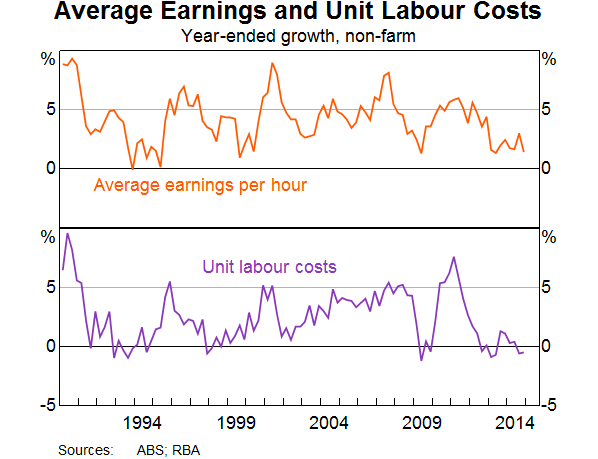
In summary, the economy is currently operating somewhat below its productive capacity. The forecast is for a gradual increase in the growth of demand and employment, and eventually a rise in non-mining business investment, supported by the very low level of interest rates. The lower exchange rate will offer some support to demand for Australian produced goods and services. Adjustments are also occurring along other dimensions, such as gains in productivity and slower growth of wages, both of which will help place the economy on a stronger footing.
So that is what I think can help, in time, to generate some more growth. It is based on a macroeconomic perspective, and draws on knowledge of the history of business cycles. It's only natural though to want more tangible evidence regarding the prospects for growth. That is, where is the growth going to come from more specifically?
Where is the growth going to come from?
In some ways this is the hardest of the three questions. It is difficult to know what new products and companies will come along, and which products and companies they might displace. And while no doubt there will be further technological progress and innovation, it is hard to predict how this will affect specific industries, especially for those not yet in existence! Nevertheless, we can say a few things about the general forces and trends that are likely to be with us for a time.
One such trend is the increasing importance of household and business services in the economy. Over the past 30 years, households have increased the share of their spending devoted to services, from about 53 to 65 per cent of their total consumption (Table 1). Health and education account for a large part of that. Households are also spending a larger share of their growing incomes on recreation and leisure services, as well as communication and financial services. The shift in spending away from goods reflects, in part, the fall in the relative prices of goods. In turn, that reflects stronger productivity growth for goods relative to services as well as the development of lower-cost manufacturers in emerging economies. That is, the world has become much better at producing goods. Mirroring these trends in consumption and production, the share of employment in household services has increased from 25 to 33 per cent over the past 30 years. This includes employment in accommodation and food, arts and recreation, education and training, and health care and social assistance. These are all things we want and need more of as our appetites for goods becomes more easily satisfied.
| 1984 | 2014 | ||||
|---|---|---|---|---|---|
| Goods | 47.5 | 34.9 | |||
| Services | 52.5 | 65.1 | |||
| Accommodation and food | 7.1 | 6.8 | |||
| Education | 2.0 | 4.6 | |||
| Health care | 4.5 | 6.3 | |||
| Arts and recreation(a) | 3.8 | 5.2 | |||
| Communications | 1.4 | 2.3 | |||
| Air travel | 1.2 | 2.0 | |||
| Financial services(b) | 6.8 | 8.9 | |||
|
(a) Services component only Sources: ABS; RBA |
|||||
Business services have increased substantially as a share of output and employment. In part this is because it has become increasingly cost-effective for businesses to outsource a lot of their ‘non-core’ functions to other more specialised industries. For example, accountants that used to work for a manufacturing firm may now be in the ‘business services industry’ helping out a wide range of different companies.
Resource production and exports are likely to continue to grow strongly for the next few years as the new LNG facilities ramp-up production. While many people across a wide range of industries helped to build those facilities, a much smaller workforce is required once they enter into production. Mining more generally is likely to continue to account for a relatively small share of total employment.
Manufacturing output has increased over the past few decades as a whole, but not as much as output from other industries. This is common to most developed economies, reflecting the increased demand for services and the emergence of lower-cost manufacturers in emerging economies. The high level of the Australian dollar has also weighed on manufacturing over recent years.[12] Those manufacturers with more exposure to the construction industry (including in mining) and focused on more complex, highly skilled techniques have tended to fare better than those exposed more to the pressures of international competition from emerging markets.
The depreciation of the Australian dollar over the past year or so is expected to support expansion of industries in the traded sector. This will benefit both goods and service industries exposed to trade. Exports of services, which include education and tourism as well as business services, were worth about $60 billion in 2014, and at current prices were a touch higher than iron ore exports at the end of last year (Graph 5).[13] Most of the growth in services exports is attributable to rapidly growing economies in the Asian region. These service industries should benefit from further strong growth of demand from that source, with many more households in Asia gaining a foothold in the middle class. While Australia has many strengths in these service industries, our comparative advantage here is perhaps not as obvious as it is in mining and agriculture, which benefit from our substantial endowments of natural resources. This means that we will need to continue to work hard to maintain competitiveness in these global markets.
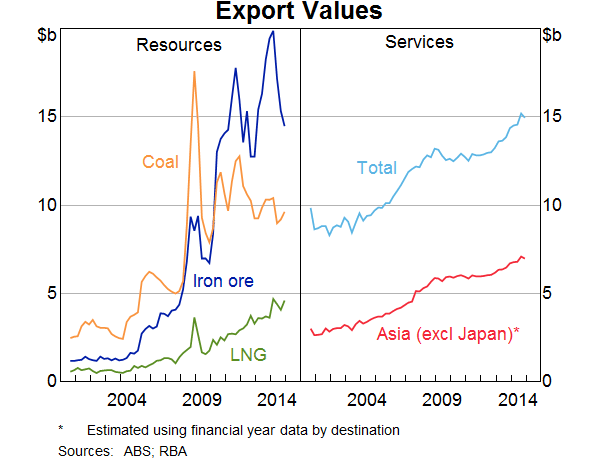
Conclusions
The Australian economy has good prospects for growth over the longer term. Among other things, we have the advantage of a well-educated workforce, strong population growth and a robust institutional framework. Also, we are closer to a rapidly developing part of the world than we are to many slower growing developed economies. We have benefited too from earlier reforms. Among other things, this has left us with more flexible and competitive product and labour markets than we had in the past and helped us to get closer to the technological frontier. However, other countries will continue to pursue reforms and we can't rest on our laurels.
The Bank's central forecast for economic activity is for growth to gradually pick up over the course of the next couple of years. Monetary policy has been and will continue to play its part in this regard. The depreciation of the exchange rate seen to date is helpful. And we shouldn't forget that there are other sources of adjustment, including the pick-up in productivity growth over recent years.
However, as we've emphasised regularly, forecasting is difficult, there are many uncertainties and better growth is not guaranteed. It is also difficult to know exactly where growth will occur. The very low level of interest rates suggests that the housing market is likely to remain strong. We will probably see a continuation of trends such as the growing importance of the services sector in our economy, which is relatively intensive in terms of employment. Resource production and exports are less employment intensive, but the significant investment in that sector will continue to bear fruit for a long time. Finally, a lower exchange rate will provide support for demand for the output of the wide range of firms operating in the tradable sector.
Endnotes
I thank Kathryn Davis, David Jacobs and James Wang for excellent assistance in preparing these remarks. [*]
See, for example, Bishop J and V Rayner (2013), ‘Industry Dimensions of the Resource Boom: An Input-Output Analysis’, RBA Research Discussion Paper No 2013-02. [1]
While I have couched this in terms of labour productivity, that in turn will depend on both multifactor productivity and capital deepening. [2]
Kent C (2014), ‘Cyclical and Structural Changes in the Labour Market’, Address on Labour Market Developments, hosted by The Wall Street Journal, Sydney, 16 June. [3]
For cross-country evidence on the links between reforms to product and labour markets and productivity, see Kent C and J Simon (2007), ‘Productivity Growth: The Effect of Market Regulations’, RBA Research Discussion Paper No 2007-04. [4]
See Gruen D (2001), ‘Australia's Strong Productivity Growth: Will it be Sustained?’, Address to CEDA/Telstra Economic and Political Overview, Sydney, 2 February; Connolly E and L Gustafsson (2013), ‘Australian Productivity Growth: Trends and Determinants’, Australian Economic Review, 46(4), pp 473–482; and D'Arcy P and L Gustafsson (2012), ‘Australia's Productivity Performance and Real Incomes’, RBA Bulletin, June, pp 23–35. [5]
Gruen D and S Shrestha (eds) (2000), The Australian Economy in the 1990s, Proceedings of a Conference, Reserve Bank of Australia, Sydney. [6]
Connolly E and L Gustafsson (2013) and D'Arcy P and L Gustafsson (2012). [7]
For more detail, see Banks G (2012), ‘Productivity Policies: The “To Do” List’, Economic and Social Outlook Conference, ‘Securing the Future’, Melbourne, 1 November. [8]
The decline in the unemployment rate following the run-up in the midst of the global financial crisis is interesting given that average GDP growth over that period was not especially strong (at 2¾ per cent per annum). The decline in the unemployment rate may, in part, reflect an unwinding of the earlier rise in unemployment, which was relatively large compared with the early 2000s slowdown (for which average GDP growth was similar). It may have been that businesses anticipated a more significant slowdown in demand during the global financial crisis than occurred, leading the unemployment rate to ‘overshoot’, with a correction thereafter. [9]
Lowe P (2015), ‘Low Inflation in a World of Monetary Stimulus’, Address to the Goldman Sachs Annual Global Macro Economic Conference, Sydney, 5 March. [10]
Plumb M, C Kent and J Bishop (2013), ‘Implications for the Australian Economy of Strong Growth in Asia’, RBA Research Discussion Paper No 2013-03. [11]
See Downes P, K Hanslow and P Tulip (2014), ‘The Effect of the Mining Boom on the Australian Economy’, RBA Research Discussion Paper 2014-08. [12]
For a discussion of tourism exports, see Dobson C and K Hooper (forthcoming), ‘Insights from the Australian Tourism Industry’, RBA Bulletin, March. [13]